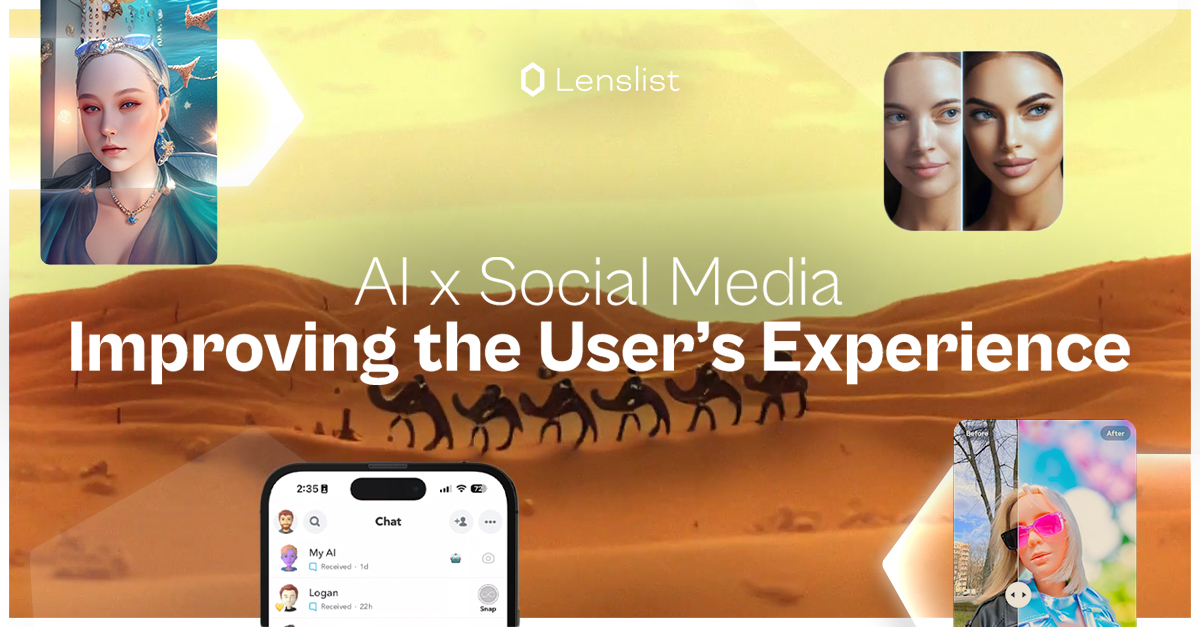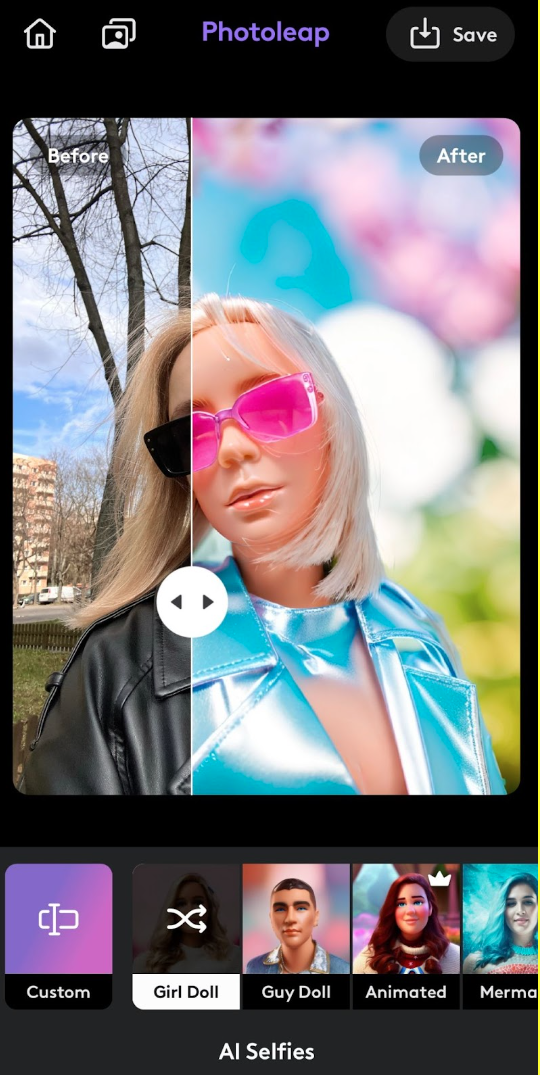AI x Social Media | Improving the Users’ Experience

With artificial intelligence getting more recognition, seeing its influence on our daily lives is not surprising. Especially with the amount of time we, as a society, spend online. But how exactly popular social media platforms are using AI systems to improve users’s experience?
When the term artificial intelligence first started trending, right before our eyes we had scenes from the science fiction movie. Self-driving cars, self-aware AI robots and in the worst cases: machines taking over the world. However exciting that might sound, right now artificial intelligence is influencing us in other ways.
But despite the rising attention AI is now catching, its use in social media is not an entirely new phenomenon. Artificial Intelligence has always helped users to navigate through different social media platforms in many ways, so it’s no surprise that with the bloom of its recent popularity, we are getting new and more advanced features.
How AI can influence social media platforms?
Suggesting Content
Some of those functionalities are subtle enough for us to not even notice them. Whether it’s suggesting a specific TV show on Netflix, a job offer on LinkedIn, or having someone to play chess online with, AI algorithms are always scanning our activity to recommend content that matches our personal preferences. It allows users to enjoy a more personalized experience on social media, which is above all, a safe space to express ourselves.
Such analysis of our activity provided by AI is not only beneficial for users but also for companies. While browsing through social media, we are more likely to interact with content that matches our interests, resulting in more time spent on the platform. That’s where statistics like engagement rates are spiking up, generating more income for brands. It also allows marketers to learn more about users (or customers) and their preferences, or social media behavior, to provide them with even more personalized content in the future.
Risks of AI-suggested content
While it is making the overall experience better for the users, it’s important to mention some of the risks of such personalization. One of the most dangerous ones is closing ourselves in a so-called information bubble, that allows you to consume only ideology that agrees with one specific point of view.
It might feel comfortable since we’re consuming things we agree with and make us feel good, but it doesn’t challenge our minds. It prevents us from gaining new thoughts and experiences, narrowing our horizons. But the good news is that it’s not something we can’t counteract. We can, for example, try following people or pages that are opposite to the content we usually absorb.
Moderation
AI is also a crucial element in moderating content. Over 75% of Internet users worldwide are considered people between the ages of 15-24, so it’s vitally important to make it a safe space. The dangers are real: from cyberbullying to concerning pictures or videos that people from all over the world can post anonymously at any time, exposing young people to triggering content. Each day there are millions of new posts on social media, and the best way to moderate it is through AI. Machine Learning algorithms are scanning each post to detect any inappropriate data.
Creating Content
Gathering information about users and suggesting matching content is just a small fraction of the part that AI is playing in social media. Especially considering the jump this technology has made in the last few years. Now Artificial Intelligence can generate content on its own, from visual images to audio effects or even videos.
This is beneficial for both users, as well as brands. You don’t have to be a licensed graphic designer to enjoy beautiful images on your company’s profile. All you have to do is open Canva or Adobe Spark and use AI tools to create a perfect social media post. Voilà! If you’re just starting out and not sure how to create aesthetically pleasing graphics – this is the best solution for you.
But you don’t have to be a professional to enjoy AI-generated content. It can be just a fun feature that allows users to interact with it, and by that, increase their engagement with the platform. Like TikTok. Scrolling through the available AR effects we can easily stumble upon experiences driven by AI. Whether for fun public content or just personal use – we can play it however we like. One of them – Bold Glamour – was especially loved by the users and went viral extremely quickly.

Here’s where the trouble begins.
TikTok, just like any other social media, brings the danger of creating an unrealistic face and body image. Until now we connected this issue mostly with Instagram, but TikTok is not falling behind. Especially with filters like Bold Glamour, that give you a makeover subtle enough to look real. Which can contribute to setting more unrealistic expectations about our image.
Still, most of the AI-based filters on TikTok are just a fun feature that users can interact with and share their results with others. Another popular AI Effect is AI Manga, with over 156M videos using the filter. As you may have guessed, it can scan your face and turn you into animated characters. Similarly, popular effects like A Green Screen, or AI image challenge, transform text into an image just by typing a few words. Let technology do the rest! Except for fun experiences to play with, AI filters can also become useful tools, for example by enhancing the picture quality (AI Enhance).
by filtersbyjulia
by sophiekatirai
by Sky Scribble
AI Assistants & Tools
Everyone is already talking about how AI will replace us, and we want to change the narrative a bit. How can it help us through the day? After all – it’s a tool for us to use. As a targeted audience, we decide how we use Artificial Intelligence. We’ve heard (or even talked to) AI-powered chatbots that help us navigate through websites and services provided by companies or assistants like Siri or Alexa. Recently Snapchat joined the fun, by introducing a new feature called My AI.
Snapchat’s My AI
While it’s based on the Open AI’s ChatGPT, users can personalize it, by adding a specific name and customizing the bot’s bitmoji. Right after releasing the feature, some people raised concerns about introducing AI to children and teenagers, who can have trouble distancing an AI bot from a real person. It’s a reasonable threat, considering that around 20% of Snapchat’s users are teenagers from 13 to 17 years old. Not to mention that you can’t disable the feature unless subscribing to the premium service which – understandably – annoyed many users. Some even accuse the bot of not being advanced enough, while others are scared of the real-person resemblance.

However, it is impossible to unambiguously say it’s badly designed, as some users are happy with the feature. Whether they use it to check homework, ask about the weather or just chat with the bot out of boredom, My AI can be in assistance with just about anything. But we have to admit: It’s not infallible. After all, Snapchat itself states:
My AI is prone to hallucination and can be tricked into saying just about anything. Please be aware of its many deficiencies and sorry in advance! So, as long as we have that in mind – we can still enjoy this feature as much as possible.
AI in art
As we mentioned, despite all of the worries considering the impact of AI on the job market, we can think about it as something that can help us in the creative process. Many artists are already working with technology to enhance the experience their work offers. Let’s look at Karen Cheng, who’s known for implementing innovative, creative solutions and connecting different types of art. In one of her recent projects, she collaborated with Luma AI to create a drone effect, without actually using it. All she needed was an AR feature and Artificial Intelligence!
But Luma is not the only app that allows users to modify their content with AI. One of the most popular ones lately is Photoleap. It’s known for generating trends on social media through fun features, like for example scanning the photo provided by the users and turning the person on it to Barbie or a Sim. You can even add a special 80s vibe to your photo!

Social Media Marketing
An influencer is probably one of the first things we think about when social media is mentioned. We thought of it as the one thing that won’t be replaced by AI – after all, it’s the human mind that’s the most important, right? Well, that might not be the case either.
While it might never fully push away the real person, it’s certainly something unique and extraordinary to implement a non-existing persona to the platform and watch it grow and engage with other users, despite it not being real.
Let’s just take a look at Miquela Sousa (@lilmiquela). It’s safe to say that her social media account and character became revolutionary in influencer marketing. While she may look, act, and collaborate with brands just like any other influencer, she’s an avatar designed by Trevor McFedries and Sara DeCou.
At this moment, she has over 2,8 million followers on Instagram and worked with brands like Calvin Klein and Prada. She was also featured in Vogue, living her life in a way most normal people can only dream about. All of that, and she doesn’t even exist!
And let’s not forget that choosing the right influence can become a crucial part of the marketing process. Brands need to choose a person (or an avatar) that aligns with the company’s beliefs and values, has enough followers, and matches the overall vibe that retailers want to promote. And AI can support marketers here as well. It can analyze and predict influencers’ behaviour, or calculate Return On Investment and choose the best content for the page. All you need is the right tool powered by AI.
The potential of AI in social media platforms
Overall, AI in social media is a growing trend that marketers can’t ignore. According to the Allied Market Research’s report, Artificial Intelligence value on social media platforms is supposed to reach $12 billion by 2031. It’s already an inseparable part of any social network, whether we see it professionally or just as users.
Looking at all of the cases and information we might wonder: How will that influence the whole picture of social media? The keyword: personalisation.
The features that we mentioned are overall contributing to creating a world that every user will be able to turn into their own safe space. And while it’s true that AI brings a lot of risks and it’s important to recognize it, we need to remember that we, as social media users and professional marketers, are the ones to control it. At least for now, we don’t have to worry about robots aware of their own existence. Human intelligence remains the future of computer science.
